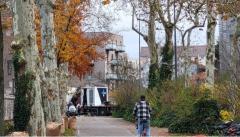
Recherche
Le cube EIKO : un modèle pour la gestion intelligente de l'énergie
Lundi 2 décembre 2024, un cube étrange a fait son apparition sur notre campus au niveau du parking du bâtiment Archimède : le cube EIKO pour un stockage d’énergie électrique à base de batteries de seconde vie. Il s’agit d’un démonstrateur bâtiment-électromobilité implémenté sur le campus Lyon Tech la Doua.
Le succès de la transition énergétique dépend de nombreux défis : impacts environnementaux, modifications de comportements, approvisionnements énergétiques, pour ne citer que les principaux. L’habitat et le transport consomment plus de 75% de l’énergie en France. La maîtrise énergétique à partir d’une approche systémique incluant ces deux domaines est donc pertinente mais aussi nécessaire pour optimiser le développement des sources d'énergie ainsi que la gestion entre ces dernières et les divers postes de consommation.
L’utilisation de stockage est aussi indispensable pour assurer l’adéquation entre l’offre et la demande en énergie, notamment dans le cadre d’un recours aux énergies renouvelables et intermittentes de plus en plus fréquent. En conséquence, le développement d’un réseau « intelligent » reliant tous ces dispositifs (sources, consommation et stockage) et qui permettrait l’optimisation des usages, prend tout son sens.
C’est pourquoi dans le cadre du projet Grid4Mobility ce cube a été disposé sur le campus. À terme, ce système sera alimenté par la centrale solaire de 30kWc installée sur le démonstrateur et sa capacité de 100kWh permettra de stocker l’équivalent de deux véhicules électriques légers. Fourni par la société Mob-Energy, ce système, utilisé à des fins de recherche, sera un élément de stockage du micro-réseau DC maillé qui assure la gestion intelligente de l’énergie.
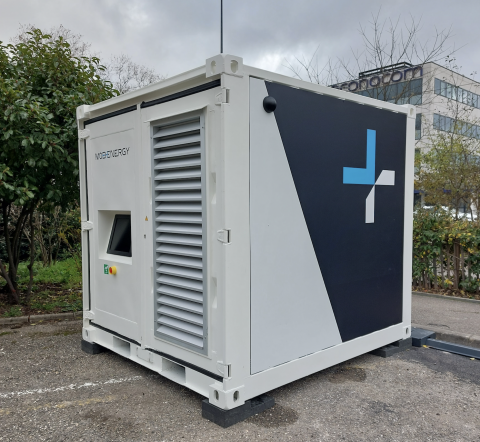
Le cube EIKO est un démonstrateur de bâtiment-électromobilité implémenté sur le campus Lyon Tech la Doua.
Grid4Mobility est plateforme expérimentale multi-site pour l’étude des réseaux énergétiques intelligents pour une transition énergétique adaptée à l’électromobilité et aux bâtiments située sur le campus Lyonnais (Campus Lyon Tech la Doua et Ecully) ainsi que la plateforme Univ. Eiffel -TRANSPOLIS (Ain). Les sites de la Doua (Villeurbanne) et d’Ecully accueillent les Unités Mixtes de Recherche en lien avec la Fédération de Recherche IngéLySE et dépendent des quatre tutelles CNRS, INSA, UCB Lyon 1, ECL. Ces Unités partagent leurs compétences dans le domaine de l’énergétique, du génie électrique, de la thermique, de l’automatique et traitement des données et de l’intelligence artificielle.
Grid4Mobility est un projet du CPER 2021-2027 financé par la Région Auvergne-Rhône Alpes, la Métropole de Lyon, le ministère de l’enseignement supérieur et de la recherche et des établissements de tutelle (INSA-LYON, Université Gustave Eiffel, CNRS, Université Lyon 1, Ecole Centrale de Lyon).
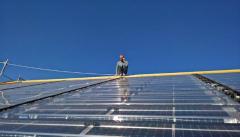
Sciences & Société
[Conférence] : La transition énergétique vue par un voisin
Conférencier : Nicolas Bonstein (ingénieur suisse spécialiste du solaire)
Ingénieur en électricité, Nicolas Bonstein a un parcours multidisciplinaire dans les technologies, mais aussi la culture, il concentre actuellement ses activités dans l’énergie solaire photovoltaïque. Passionné par le monde dans lequel nous vivons, il ne cesse d’apprendre et aussi de transmettre ses expériences et son vécu.
Au programme de cette conférence :
- Un très bref coup d'œil sur le dernier rapport du GIEC
- Une présentation du système politique Suisse
- Le plan helvétique pour atteindre les objectifs de la COP21 de Paris
- Quelles sont les technologies solaires, aujourd'hui à disposition en Suisse
- Un exemple pratique d'assainissement énergétique dans le bâtiment.
Sous-jacent de cette présentation, c'est le rôle et les responsabilités des ingénieurs dans cette période cruciale qui seront abordés, mais aussi la systématique d'approche pour la résolution et la réalisation d'un projet technologique.
Additional informations
- scd.animation@insa-lyon.fr
- https://bibliotheque.insa-lyon.fr/cms/articleview/id/6920
-
Bibliothèque Marie Curie - Amphithéâtre Emilie du Châtelet - INSA Lyon
Keywords (tags)
Last events
Exposition « Cosmos » - création collective (FASSIL 2025)
From 06 Nov to 17 Dec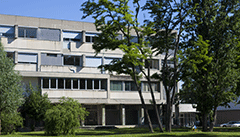
Sciences & Société
Soutenance de thèse : Janett Ruiz
Gazéification en lit fixe co-courant : étude des transitoires
Doctorante : Janett RUIZ
Laboratoire INSA : CETHIL
Ecole doctorale : ED162 : MEGA
La gazéification de combustibles alternatifs permet la production locale et non- intermittente d’énergie renouvelable et peut devenir une contribution majeure à la transition énergétique et à la promotion de l’économie circulaire et territoriale. Les réacteurs à lit fixe co-courant sont les mieux adaptés aux enjeux territoriaux liés à la valorisation des déchets. Dans ces réacteurs, le taux de conversion est élevé mais la conversion homogène du combustible est difficile à atteindre et représente une barrière à leur utilisation à des performances optimales. Dans ce contexte, le projet ECoGaz (valorisation Énergétique de COmbustibles alternatifs issus de déchets par GAZéification) vise à accroître les connaissances afin de développer l’utilisation de la gazéification pour la conversion de combustibles alternatifs dans ces réacteurs. Ainsi, le principal objectif de ce travail de thèse est de proposer un modèle numérique fiable de gazéification en lit fixe co-courant permettant de représenter avec justesse la conversion de combustibles complexes. Dans le modèle développé dans cette thèse, les phénomènes réactionnels fortement couplés à l’écoulement de la phase gaz et aux phénomènes de transfert thermique dans le milieu poreux sont simulés de manière satisfaisante. Le tassement a été pris en compte. Le caractère 2D du modèle permet d’observer et de comprendre des phénomènes difficiles à mesurer. Ces informations peuvent être précieuses pour comprendre certains dysfonctionnements des réacteurs à lit fixe. De plus, ce modèle pourrait être utilisé comme outil de dimensionnement du réacteur. L’influence de plusieurs paramètres opératoires pourrait être étudiée, tels que le diamètre du réacteur, la composition de l’agent oxydant, le ratio équivalent ou l’emplacement de l’injection. D’autre part, la composition du combustible, et le diamètre des particules sont des paramètres d’entrée du modèle, qui permettent l’étude de différents intrants hétérogènes afin de valider la faisabilité de leur conversion dans un réacteur à lit fixe co-courant.
Additional informations
-
Amphi OUEST Bat. « Les Humanités » - Villeurbanne
Keywords (tags)
Last events
Exposition « Cosmos » - création collective (FASSIL 2025)
From 06 Nov to 17 Dec
Formation
Energy transition: INSA fuels the critical thinking of its students
Resource depletion, greenhouse gas emissions, local pollution... The list of disastrous effects of predominantly fossil-based energy production is no longer a secret. Although the use of renewable solutions currently represents only 11% of total French energy production, there are many future scenarios. Fifth-year students in the electrical engineering department (GE) attended a conference with Marc Jedliczka, spokesperson for the NegaWatt association, which aims to rethink the French energy model.
The NegaWatt scenario
‘Energy is not a goal in itself. The aim is to meet energy needs’. This is how Marc Jedliczka introduced his topic at the recent conference given to fifth-year GE students. The NegaWatt approach can be summed up in three key concepts: restraint, energy efficiency and renewable energies. ‘It’s a common-sense approach. By reducing the amount of energy needed at source for the same service, by prioritising essential energy needs, and by developing renewable energy sources, we can begin to contain runaway climate change. Although the NegaWatt approach does not offer a technological breakthrough, it admits that this same technology can help reduce consumption needs. This is the work of engineers’, says the association’s spokesperson.
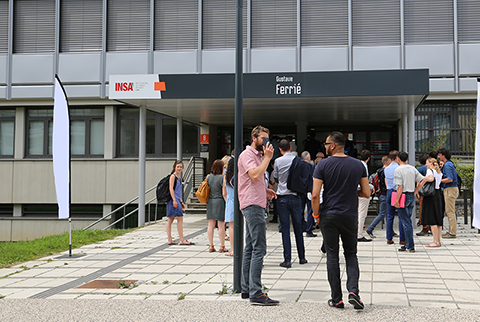
Introducing electrical engineering students to alternative means of production
As electricity specialists, these engineering students are undoubtedly concerned by the issue of energy transition. Claude Richard, a lecturer in the GE department at INSA Lyon, explains how engineering students are taught there. ‘To move towards more renewable energy and rationalisation of energy use, we need engineers who understand the energy system as a whole. Since electrical energy is currently one of the main energy carriers, we make it a point of honour to support our students’ reflection, in particular through the ’fifth-year GE industrial conferences’ and business creation projects focused on energy transition with third-year students in the department. The arrival of Marc Jedliczka is also in response to strong demand from students who, feeling increasingly concerned by the climate emergency, wish to open their minds to the use of intermittent energies such as renewable energies. However, these systems require agile and skilled engineers in power electronics, electrical engineering, mechatronics and also the implementation of electronic control and communication systems. The challenges of electrical systems, energy distribution and conversion and related intelligence are key areas of expertise in multidisciplinary GE education and will also be at the centre of future energy upheavals’.
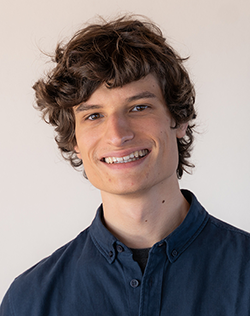
Between vision and concrete actions
Noé Delargillière, an INSA graduate in energy and environmental engineering, joined the Institut NégaWatt 1.5 year ago as a project manager. ‘The Institut NégaWatt is the operational arm of the vision developed by the eponymous association. Today, the building industry is the largest consumer sector in France. My work consists of jointly devising building renovation strategies with local authorities and business park managers. We are working together to reduce energy consumption in order to meet the targets set by law, and to do this, we need to involve decision-makers and teams around important changes. I am an engineer who does consulting - a large part of my job is to make results understandable and help overcome resistance to change. I think that going back and forth between a vision and concrete actions is part of the engineer’s role in energy transition. I am convinced that technology and engineering should no longer be seen as something neutral, but must be part of a long-term commitment and vision because we have decisions to make in the years to come’, concludes the young engineer.
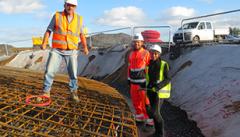
Recherche
Wind repowering: laboratoire GEOMAS optimises the foundations
About twenty years ago, the first French wind turbines flourished on the hills in the south and the great plains in the north of the country. Today, wind power is the second largest primary source of renewable energy. However, after twenty years of operation, wind farms are in danger of becoming obsolete, causing economic and environmental problems. The FEDRE1 project aims to optimise the foundations of existing wind turbines in the face of the constraints imposed by new equipment, which is more powerful than a few years ago. Meeting with Laurent Briançon, associate professor at laboratoire GEOMAS (Geomechanics, Materials, Structure) and scientific director of the project.
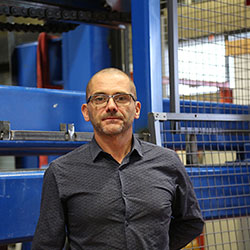 As onshore wind turbines have a lifespan of between twenty and twenty-five years, the problem of re-equipment is beginning to emerge on French wind farms. For wind farm operators, there is an alternative way to increase energy supply without installing additional wind turbines: ‘repowering’ consists of replacing old equipment with more powerful models. ‘As we will soon reach the maximum number of wind turbines that can be installed in France, the manufacturers propose increasing the power to avoid building new ones, but there are technical constraints to this’, explains Laurent Briançon.
As onshore wind turbines have a lifespan of between twenty and twenty-five years, the problem of re-equipment is beginning to emerge on French wind farms. For wind farm operators, there is an alternative way to increase energy supply without installing additional wind turbines: ‘repowering’ consists of replacing old equipment with more powerful models. ‘As we will soon reach the maximum number of wind turbines that can be installed in France, the manufacturers propose increasing the power to avoid building new ones, but there are technical constraints to this’, explains Laurent Briançon.
Made up of a rotor, a nacelle and a mast, a conventional on-shore wind turbine2 rests on a circular reinforced concrete base with a diameter of about twenty metres. The new equipment offered by repowering is larger, heavier and, above all, more of a burden on the foundation. ‘The current proposed solution to replace the equipment is to deconstruct the entire reinforced concrete footing to build a stronger one to accommodate the new masts. Our team is working to adapt this new equipment to the existing foundations to avoid this costly and environmentally unfriendly solution. It should be noted that the construction of a foundation alone accounts for 10% of the total cost of the wind turbine, and the used concrete blocks are neither reusable nor recyclable because of their scrap density. The tonne of cement needed to manufacture the new footing represents almost 900kg of carbon dioxide. Imagine the number multiplied by the 8000 or so wind turbines installed in France!’
In the next ten years, 50% of Europe's wind farms will have to be re-equipped. The FEDRE project team hopes to participate in improving the integration of wind power in the energy landscape and to improve the competitiveness of the sector. ‘If our solution is viable, we would like to set up an economic interest grouping with the consortium we have formed. The share of renewable energies in the world is still too low compared to fossil fuels. We hope to be able to participate in cleaner repowering of wind turbines’, concludes the laboratoire GEOMAS researcher.
Find out more: http://fedre.insa-lyon.eu/fr
1 Foundations of Sustainable Wind Turbines and Repowering
2 An onshore wind turbine is by definition installed on land and differs from offshore wind turbines installed at sea.

